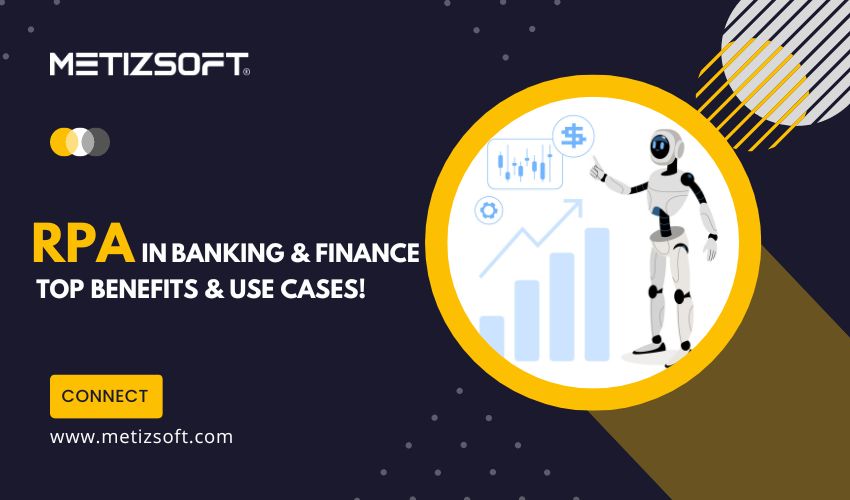
Banking is one of the most engaging industries, with countless business operations involving money and private data. The rapid technological evolution has enabled the banking industry to adapt quickly, remain competitive, and provide exceptional customer experiences.
More than competitive and accurate, the banking sector faces numerous other challenges. It includes scarcity of skilled resources, the need for process efficiency, and a sharp increase in personnel costs. This led them to adopt highly advanced automation technology like Robotic Process Automation and RPA.
In this blog, we will discuss the use of RPA in the banking and financial industry. Consequently, its benefits, implementation strategies, and use cases.
Table of Contents
RPA in Banking & Finance – Overview!
The role of RPA in banking and finance is similar to what it is in the insurance sector. It has revolutionized both industries inside and out with its automation capabilities. RPA streamlines banking operations, reduces costs, and increases efficiency.
According to McKinsey, there will be a second wave of automation and Artificial Intelligence called Intelligent Automation. This will involve software bots and machines executing 10% to 25% of tasks across various banking functions. As a result, the workforce can focus on higher-value tasks and projects while the bank’s capacity broadens.
Key Benefits of RPA in Banking & Finance!
RPA is revolutionizing the banking and finance industry by optimizing operations and enhancing customer experience. Many have already adopted RPA in their banking segment. For those who haven’t yet and are confused, here are the top 6 benefits RPA brings to the banking industry:
Reduce Tedious Banking Operations – The banking sector is one of the busiest industries. Every day, bankers perform various high-volume tasks that require sheer dedication and accuracy. Hence, they often struggle to meet customer demands within the hurdle.
Integrating Robotic Process Automation within the system automates the entire process. Moreover, it also provides them extra time to take care of other productive tasks. Bots work 24*7, 365 days without getting tired, making them a valuable solution.
Reduce Cost – Reducing redundancy and automating processes can lower costs for banking and finance firms. Enabling Robotic Process Automation (RPA) in financial systems can save up to 25 – 30% by increasing efficiency, reducing energy consumption, and saving time.
Ensure High-end Scalability – Robots have a high scalability level, enabling them to manage large volumes of work during peak business hours. This is especially useful when there is a need for bots to respond to a situation quickly.
Additionally, implementing RPA allows banks to focus on innovative strategies. Implementing those strategies helps bank employees get ample time to grow their banking operations to the next level.
Improve Accuracy & Reliability – Humans are prone to errors. That’s what separates us from machines. However, in the banking process, even minimalist mishaps might cause a grave mistake that leads to behemoth losses for the organization. It also hampers the bank’s reputation in the circle.
RPA can efficiently manage processes and voluminous data, complying with technological advancements like AI and Machine Learning. It seamlessly adapts to quick changes in numbers and documents and brings the best possible results.
Compliance With Regulations – The banking and financial industry has various regulations they must comply with globally.
The primary objectives of regulatory compliance are to align business practices with the regulations and maintain excellent reporting and record-keeping to prepare for audits.
Thankfully, Robotic Process Automation can help alleviate some of the challenges associated with compliance and auditing. RPA is the next-gen technology that automates repetitive and manual tasks by assigning them to software robots.
Improve Customer Experience – Organizations, including those in banking and finance, prioritize customer experience. However, busy industries often lack efficient customer service and communication.
However, with RPA in place, banks can comprehensively integrate bots to address customer inquiries attentively and offer suitable solutions to work with customers.
Potential Use Cases RPA Brings to the Banking & Finance!
RPA has numerous applications in the banking and finance sector, allowing for the automation of repetitive tasks and the redeployment of staff to focus on more critical work.
Here are some verified, real-time RPA use cases in banking for your consideration:
Customer Onboarding – Customer onboarding in banking institutions tends to be lengthy and tedious due to the need for manual verification of various documents. However, the process can become much more efficient with RPA implementation.
RPA can capture data from Know Your Customer (KYC) documents using Optical Character Recognition (OCR) technology. This data can then be compared and verified against the information provided by the customer on the required forms.
Automatic Report Generation – Generating Suspicious Activity Reports (SARs) is a routine compliance task for banks and financial institutions to report fraudulent transactions.
RPA technology can have natural language generation capabilities to sift through lengthy compliance documents, extract the necessary information, and file a SAR. To achieve the best results, compliance officers can train the RPA software to identify the relevant parts of each document that fit specific sections of the report.
Account Opening – By implementing RPA, the typically complicated process of opening a new account becomes much more straightforward, faster, and more accurate. Automation helps to remove any mistakes in data transcription between the core banking system and the new account opening requests, improving the quality of the entire system’s data.
Loan Process Optimization – Loan processing has always been considered a slow process. Although banks have automated it to a certain extent, RPA further accelerates the process and brings it down to 10-15 minutes for processing.
Credit Card Processing – Automating identity verification, background checks and decision-making processes speeds up credit card application processing and improves customer experience.
KYC Management – Automating the KYC process through rule-based procedures simplifies and speeds up the process while minimizing disruptions to existing systems. This is a mandatory process for every bank customer.
Fraud Detection – Continuous monitoring of customer transactions using RPA tools to detect and flag potential fraud for human review based on preset rules.
Trade Settlement – Automating trade settlement processes involves extracting relevant trade data, matching confirmations, validating settlement instructions, and generating reports. This improves accuracy and speeds up settlement processes.
Risk Management – Automating risk assessment and management practices through RPA-enabled data collection, modeling, scenario analysis, and reporting.
Regulatory Reporting – Automating data collection, analysis, and reporting necessary for regulatory compliance, ensuring timely and accurate reporting while reducing non-compliance risk.
By selecting the proper use case and configuring it properly, RPA can significantly speed up core processes, reduce operational costs, increase productivity, and lead to more high-value work in the banking industry.
Ways to Implement RPA in Banking & Finance!
After creating the Automation Roadmap, financial institutions can proceed with a ‘Proof of Concept’ to demonstrate benefits and refine the automation approach.
To implement RPA effectively, banking organizations can follow the steps listed below:
- Shortlist the processes that are suitable and require RPA implementation
- Prepare a multifaceted automation roadmap
- Research, identify, evaluate, and partner with the right RPA service providers
- Develop a strategy for governance and a delivery model.
- Plan training sessions and develop a change management strategy.
Following the above strategy will ensure a seamless implementation of Robotic Process Automation in the banking and finance sector. If you desire better and error-free execution, contact a renowned RPA development agency!
Final Thoughts!
A thorough knowledge of the database platform used by a specific bank, the ERP and CRM platforms used, and all the other management platforms used is crucial. Therefore, this is key to implementing RPA in the banking and finance industry.
It’s not what you can think and do in a fortnight. It requires planning, understanding, and high-level execution. At Metizsoft Solutions, we feature a robust and agile RPA expert team, ensuring seamless RPA implementation in your banking system.
AboutManthan Bhavsar
Related Posts
Robotic Process Automation (RPA) – Definition and Types!
Over the years, humans have been the driving force of all business. They still are, though, with the support of technological...
RPA in Insurance – Role, Benefit, Use Cases & More!
Insurance companies/organizations, in their early days, were heavily accustomed to the most traditional ways of task...

